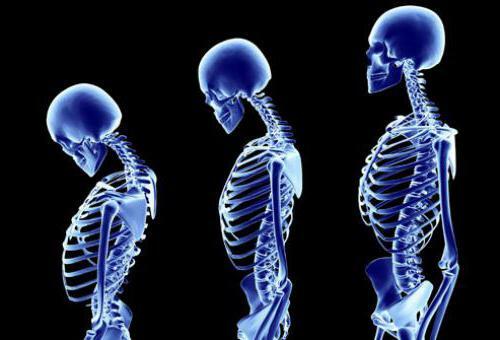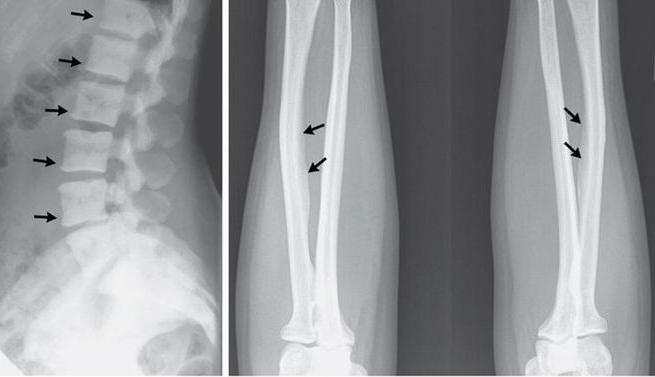Bone diseases: types, symptoms and treatment
As you know, the skeleton is the support for the whole organism. Without the bone system, we could not only carry out various movements, but even stand. Therefore, the skeletal support function is one of the most important abilities necessary for life.
Unfortunately, bone diseases are quite common. Most often they are associated with joint pathologies. In most cases, problems with the musculoskeletal system begin to appear in the elderly. Especially often they develop in women who are in the menopause period. Nevertheless, bone pathologies occur in people of all ages. No exception - children and newborns.

Pathologies of the osseous system: a description of
Diseases of bones and joints are characterized by impaired musculoskeletal function, which are reflected by symptoms such as gait alteration, inability to tilt or turn, deformity of the limb or spine. Pathologies can be both congenital( genetically incorporated), and acquired during life. Diseases are divided into localized( span one or more bones) and common, which affect the entire musculoskeletal system. Pathologies can have inflammatory, genetic( congenital anomalies), tumor character. Also, lesions of the musculoskeletal system include fractures, joint dislocations, deformities and contractures in system pathologies of the body. Diseases of human bones have the same prevalence throughout the world. More often they are found among the female population. Nevertheless, the percentage of men who have pathology of the musculoskeletal system is also great.

Disease of bones and joints: varieties of
The etiology of osteoarticular pathologies is different. It depends on what kind of disease takes place in a particular case. On this basis, pathologies are divided into the following groups:
- Dystrophic lesions. These include rickets in childhood and osteoporosis, which occurs in adults. They arise because of the insufficiency of microelements( calcium, phosphorus).Lack of these substances can occur with malnutrition, as well as a violation of the thyroid gland, ovaries.
- Inflammatory pathologies - osteomyelitis. This disease develops as a result of the introduction of microbial agents into bone tissue. In this case, its destruction - necrosis.
- Traumatic injuries of the musculoskeletal system. These include cracks and fractures of bones. Also, this group includes damage to the joints and ligaments( dislocation, sprain).The causes of bone diseases of a traumatic nature are strokes, compression and other mechanical factors.
- Degenerative( dysplastic) pathology. To include osteoarthritis, Bechterew's disease. The etiologic factor of these pathologies is precisely unknown. It is believed that they can have a genetic( genetic) character, and also belong to autoimmune lesions of bone tissue.
- Tumor lesions of the musculoskeletal system.
- Rare genetic syndromes. These include Paget's disease, imperfect osteogenesis, etc.
Causes of development of bone pathologies

Despite the fact that all bone diseases have different etiologies, there are factors that provoke any of the listed pathologies. These include the following impacts:
- Incorrect power. Inadequate intake of foods rich in calcium leads to a decrease in bone density. As a result, adults develop osteoporosis.
- Lack of sunlight. This cause leads to a disease like rickets. This pathology is common in young children.
- Breaking the hormonal background. Especially it concerns a thyroid gland. This body is responsible for maintaining a balance between calcium and phosphorus, necessary for the bone system. Also, the pathology of the musculoskeletal system can lead to disruption of parathyroid glands and ovaries. Excessive loads on the skeleton. This reason implies constant weight lifting, prolonged physical exertion, obesity.
- Chronic foci of infection. It is worth remembering that bacterial or viral damage of any organ can lead to the penetration of microbes into the bone system.
- Systemic pathologies.
- Genetic predisposition to diseases of bones and joints. For example, osteoarthritis or gout in the parents.
Clinical picture in bone pathologies
Symptoms of bone disease depend on the pathology itself, and also on the degree of its severity. Nevertheless, the clinical picture of diseases of the musculoskeletal system has some common characteristics. These include unpleasant sensations during movements, deformation of the bone or joint, swelling and soreness in the lesion. These signs are typical for almost all pathologies. Inflammatory bone diseases in addition to these symptoms are manifested by increased body temperature, general weakness, loss of appetite.
This pathology, like osteoporosis, may not have any clinical picture. To suspect a disease is usually possible because of frequent traumatization of the patient, leading to fractures of bones.
Another pathology that has a dystrophic character is osteomalacia. In adults, it can be considered an independent disease, in children - the manifestation of rickets. The main symptom of osteomalacia is soreness in the place of softening of the bone, unpleasant sensations when walking.
Clinical manifestations of cancer of the musculoskeletal system depend on the stage of the process. Usually a tumor is characterized by the appearance of a segment of compaction( elevation) along the bone that tends to grow. In severe stages, there is an increase in lymph nodes, subfebrile temperature, weakness.

Diagnosis of the pathology of the musculoskeletal system
To determine what diseases of the bones can be observed in the patient, it is necessary to conduct a survey not only of the musculoskeletal system, but of the whole organism as a whole. The main reason for contacting the clinic are complaints of pain, restriction of movement, deformation. The specialist should find out the following factors: whether there was a trauma or excessive physical exertion. After this, an examination of the osteoarticular system is performed. The doctor asks the patient to make various movements and assesses their performance. Among the laboratory data are important indicators such as leukocytes and ESR, uric acid, calcium and phosphorus. Also, if the patient complains of tenderness or stiffness of joints, it is necessary to conduct an analysis for the detection of rheumatoid factor. In addition, radiography of the bones is performed. If necessary, computer tomography is performed.

Differential Diagnosis of Bone Diseases
In order to distinguish one disease of bones from another, you need to carefully examine the patient. When getting injuries immediately carried out X-ray, and the diagnosis is not difficult. Inflammatory process can be suspected due to examination of the limb( the presence of a wound with purulent contents, hyperemia and edema), an increase in body temperature, laboratory data( leukocytosis, acceleration of ESR).Dystrophic changes in the bones are diagnosed with an X-ray. If a tumor or cyst is suspected, a CT scan is performed. Such pathologies as osteoarthrosis or ankylosing spondylitis are detected( to a greater extent) due to the clinical picture. They are characterized by a pronounced deformation of the musculoskeletal system and a change in gait.

Diseases of the bones: treatment of pathologies
Even with minor soreness or restraint, consult a doctor. When getting injured, it is important to make an X-ray in time and apply a cast, since the bone may not properly be welded, after which a longer treatment will be required. Also, medical care must be treated when ulcers occur. Especially it concerns patients suffering from diabetes mellitus and varicose veins. Despite the fact that these pathologies are not associated with the musculoskeletal system, trophic ulcers can lead to the development of osteomyelitis. With curvature of the spine, flat feet and gait disturbance, one should consult an orthopedist. The traumatologist is responsible for fractures and dislocations of the joints. Rheumatologist specializes in inflammatory reaction as a result of autoimmune process.

Diet therapy for bone pathologies
Any bone disease is an indication for adherence to a diet. Proper nutrition will help not only to strengthen the bones, but also to avoid further development of pathology. Most of this concerns traumatic and dystrophic diseases. To ensure the proper level of calcium in the body, it is necessary to use dairy products. The greatest content of this element is observed in hard sorts of cheese, cottage cheese, kefir. Also sources of calcium are liver, cabbage and nuts. It is not recommended the use of sugar, grapes, beans and alcoholic beverages.
Medical and surgical treatment of
In cases of inflammatory diseases of bones and joints, the drugs of the NSAID group are used. They include medicines "Diclofenac", "Artoxane", "Aeralt".Anesthetics are also recommended. For example, the drug Ketonal. This medication is also necessary for traumatic bone lesions. In women, menopause often develops osteoporosis. To reduce the fragility of bones, the use of estrogen-containing drugs is recommended. With severe deformation of the musculoskeletal system, surgical intervention is performed. Also, surgical treatment is indicated in case of detection of a tumor and the development of osteomyelitis.
Prevention of bone pathologies
To avoid the appearance or development of bone pathologies, it is necessary to follow the diet, get rid of excess weight. It is also recommended to perform a set of physical exercises, but here the main thing is not to overdo it. Prevention of inflammatory processes is sanation of foci of infection and antibiotic therapy during exacerbation of chronic diseases( sinusitis, tonsillitis).
